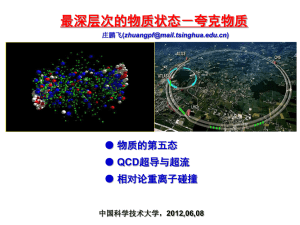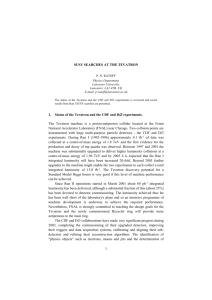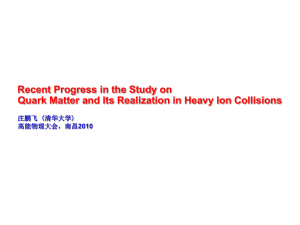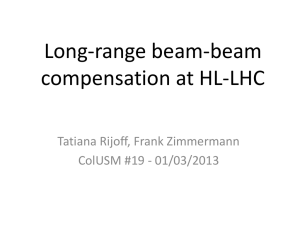ppt - Rencontres de Blois
advertisement
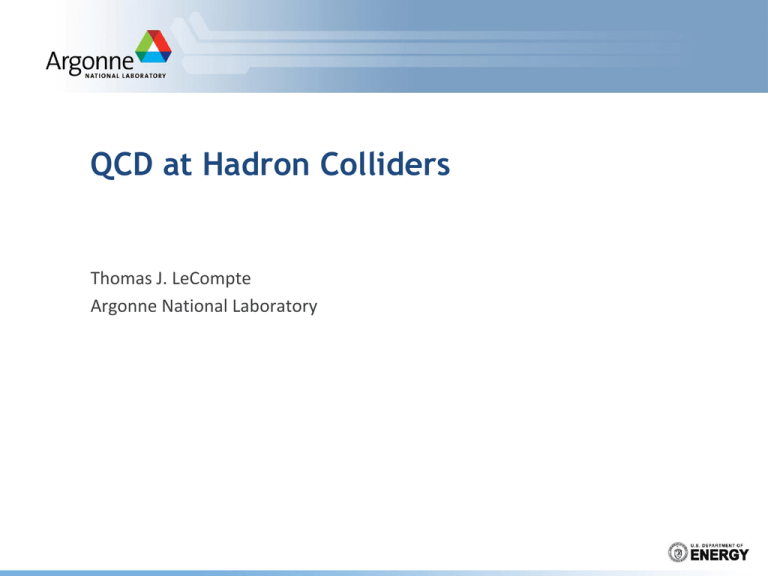
QCD at Hadron Colliders Thomas J. LeCompte Argonne National Laboratory Why Is This Important? At the LHC, we get events like this. QCD is either your signal or your background; either way, it must be understood. 2 Portrait of a Simple QCD Calculation One part: the calculation of the “hard scatter” PERTURBATIVE 3 Portrait of a Simple QCD Calculation One part: the calculation of the “hard scatter” Another part: connecting the calculation (which involves gluons) to protons (which contain gluons) PERTURBATIVE NON-PERTURBATIVE 4 Portrait of a Simple QCD Calculation One part: the calculation of the “hard scatter” Another part: connecting the calculation (which involves gluons) to protons (which contain gluons) Last part: the fragmentation of final-state gluons into jets of particles PERTURBATIVE NON-PERTURBATIVE NON-PERTURBATIVE 5 Comparison with Experiment Our experience has been that progress is made when we already know 2 of the 3 parts. – Experiment then constrains the third. Hard Scatter Parton densities It is possible to gain information when this is not true, but the situation is much more confusing. Fragmentation 6 Outline I will show a few examples from each category – Initial state: direct photons, jets – Hard scatter: W/Z + jets – Fragmentation: the b-quark cross-section saga I hope to set the stage for the new and exciting results that we will hear about over the course of the week. I apologize for not including results from RHIC in this talk. 7 Parton Density Functions Today One fit from CTEQ and one from MRS is shown – These are global fits from all the data Despite differences in procedure, the conclusions are remarkably similar – Lends confidence to the process The gluon distribution is enormous: – The proton is mostly glue, not mostly quarks Want to know the uncertainties? Use the Durham pdf plotter: http://durpdg.dur.ac.uk/hepdata/pdf3.html 8 HERA: Before and After HERA revolutionized our knowledge of parton densities – If you don’t believe me, look at papers pre-HERA and post-HERA – It’s even more dramatic than it looks, as the shapes in the left plots are still informed by the HERA data. Otherwise, the shapes would be more a function of imagination than of physics. There is still a need to explore for the LHC, where higher Q2 matters. 9 Kinematic Reach of a 7 TeV LHC LHC @ 7 TeV Reach with Jets & Photons LHC @ 7 TeV Reach with W’s In the 2010-11 Run, the LHC has substantially increased the kinematic range available for study. In particular, W production allows probing low x, high Q2 quarks and antiquarks. The 7 TeV data “fills the gap” between the Tevatron and a 14 TeV LHC. From CTEQ: these are the inputs to CTEQ5 10 Direct Photons and the Gluon PDF DIS and Drell-Yan are sensitive to the quark PDFs. q g Gluon sensitivity is indirect – The fraction of momentum not carried by the quarks must be carried by the gluon. It would be useful to have a direct measurement of the gluon PDFs – Even if it were less sensitive than the indirect measurements, it would lend confidence to the g picture that is developing q – It also has the potential to probe higher Q2 than Direct photon “Compton” process. the indirect methods. – This process depends on the (largely known) quark distributions and the (less known) gluon distribution If this is such a good idea, how come this process is unpopular with the global fits? 11 Tevatron Data 12 Tevatron Data There is a discrepancy at low pT, seen by both experiments. There are theoretical ideas on how to resolve this, but the cross-section calculation and the PDF measurements have become intertwined. – We are attempting to constrain 2 of the 3 parts simultaneously. 13 Photons at the LHC 14 Photons at the LHC There is still something not understood going on below 50 GeV – But we know now that this is a function of ET, not of xT. We can separate PDF effects from the calculational issues. The additional kinematic reach of the LHC is apparent – – – – For the same xT, the LHC goes out 3.5x farther in ET. With only 1% of the data, the kinematic reach is the same as the Tevatron’s This represents 1-10% of the data the LHC has already collected The troublesome region below 50 GeV is a tiny piece of what will be studied 15 Jets at the LHC Cross-section measured over 10 orders of magnitude. – – Reminder: this is a mix of qq, qg and gg states. In 6 or 7 bins of rapidity With jets with ET’s above 1 TeV. How does this agree with QCD predictions? – Both experiments already understand their jet energy scales to a few %. You can’t tell from a log plot 16 ATLAS data, so you can see it. The agreement with NLO QCD is quite good (over 8 orders of magnitude!). Possibly something is going on in the far forward region at high pT. This is a tough region theoretically (low x, high Q2) as well as experimentally (starved for statistics to check the JES). 17 CMS data, so you can see it. Again, impressive agreement, with the possible exception of energetic forward jets. 18 W/Z+Jets: Why You Care This is the sort of event that shows up in SUSY searches. – This particular event has no leptons, 3 jets and 420 GeV of missing ET. The dominant background in these searches is W/Z+jets – Real missing energy from real neutrinos. History repeats itself. 16 years ago the discovery of another particle depended on understanding the W+jets background. 19 Some Tevatron Results on Z+jets With fb-1 sized datasets, comparisons with theory possible up to the ~200 GeV range for Z’s; a bit more for W’s. 20 Things are a little different at the LHC At the LHC, jet multiplicities are higher, and with 3% of the data collected, the range of pT’s accessible is about the same – maybe already a little larger. 21 I don’t want to forget W+jets At the LHC, the top quark is a significant background to W+jets. (At the Tevatron, it’s the other way around. 22 Z+b jets CMS has a cute result where they start with a Z+jets analysis and b-tag a jet. With the large number of W/Z+jets events, expect to see more examples of this kind of closer look at the data. Since this probes the bquark content of the proton, this is perhaps a better example of the 1st part of a QCD calculation than the 2nd. 23 And an Interesting Result from CDF This is the dijet mass in W+2 jet events Obviously, a bump is an exciting thing. However “I see bump” ≠ “there is a particle” – It will be interesting to hear what D0 says when they are ready – The LHC does not report seeing this, although it’s not clear that it would be expected to. 24 Can This Be Explained by the JES? From Tommaso Tabarelli de Fatis 25 Lessons I Learned from this Bump I do not believe CDF’s jet energy scale is off by 4%. This would show up in too many other places to go unnoticed. I have no trouble believing ALPGEN’s predictions are good to only ~4% today. – This may just be a statement of my experimenter’s bias – We are asking a very difficult thing of our generators – predict QCD with enough accuracy that we can spot an EWK-sized effect. – I think this underscores the need to make as many measurements as we can to compare with generators 26 The b-quark cross-section saga At DPF92, CDF reported bottom quark cross-sections a factor of at least two greater than theory. This was at a center of mass energy of 1800 GeV. UA1 measurements at 630 GeV agreed better with theory – However, both theoretical and experimental uncertainties were substantially larger. Community reaction: someone (i.e. CDF) probably mismeasured something. Wait a while and this will go away. 27 But, it didn’t go away. More recent CDF measurements showed the same difficulty – the theory underpredicts the data by the same factor This problem was not going away Note that CDF (and also D0) measures only the high pT tail of the cross-section – Most b’s were invisible. 28 Commentary on measuring the top 10% of something Just how important could the other 90% be anyway? 29 The Answer: CDF measured J/y from b decays Allowing unfolding to the b x-sec s 29.4 0.443..19 b NLO QCD predicts 20-40 b Since the total cross-section agreed, but the high-pT portion did not, we had a shape problem, not a size problem. – The spectrum was stiffer than previously thought – causing us to mistake one for the other. Understanding fragmentation was the key – getting from the s(b-quark) calculation to the s(b-hadron) measurement. – Once that was understood, the other parts (PDFs and detailed calculation) followed. – All three contributed at some level. 30 Summary There are three parts to a QCD calculation: the initial state (PDF’s), the hard scatter, and the final state (fragmentation). We make progress fastest when two are well understood, and comparison with experiment directly probes the third. HERA revolutionized PDF’s. – The Tevatron and the LHC are exploring regions in the (x,Q2) plane inaccessible to HERA. Hard scattering calculations have been steadily improving – but so have the demands we are placing on them. – We are asking our W+2jets calculation good enough to see new EWK-sized physics. Fragmentation usually doesn’t limit our understanding, but still has the capability of surprising us. At the LHC, whatever physics you intend to do, QCD is going to be part of you life. 31 Thanks! Thanks to the organizers for inviting me… …and the ATLAS, CDF, CMS H1, D0 and Zeus collaborations, without whom I would have had a very short talk. 32
